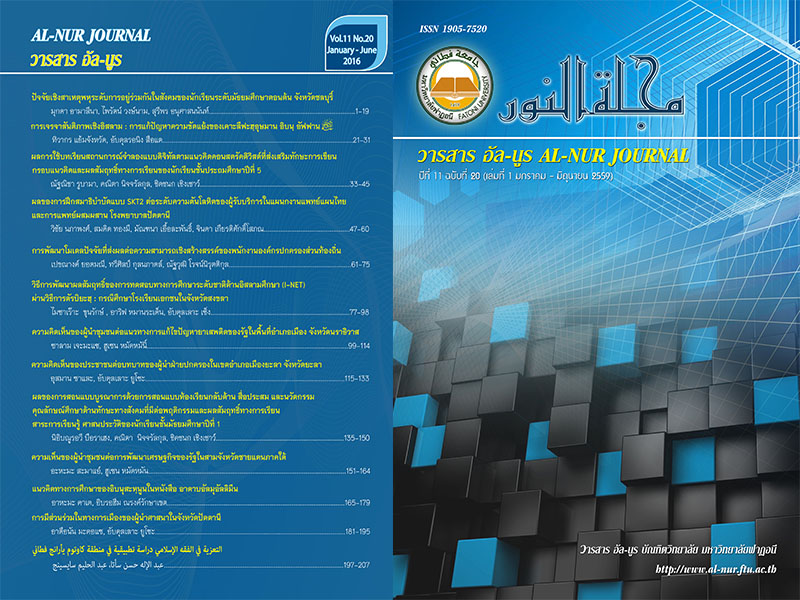ปัจจัยเชิงสาเหตุพหุระดับการอยู่ร่วมกันในสังคมของนักเรียนระดับมัธยมศึกษาตอนต้น จังหวัดชลบุรี
Abstract
บทคัดย่อ
การวิจัยครั้งนี้มีวัตถุประสงค์เพื่อ 1) พัฒนา ตรวจสอบความตรงของโมเดลสมการโครงสร้างพหุระดับการอยู่ร่วมกันในสังคมของนักเรียนระดับมัธยมศึกษาตอนต้น จังหวัดชลบุรี 2) เพื่อศึกษาปัจจัยเชิงสาเหตุการอยู่ร่วมกันในสังคมของนักเรียนระดับมัธยมศึกษาตอนต้น จังหวัดชลบุรี จำแนกตามระดับนักเรียน และระดับโรงเรียน 3) เพื่อพัฒนาโมเดลสมการโครงสร้างพหุระดับการอยู่ร่วมกันในสังคมของนักเรียนระดับมัธยมศึกษาตอนต้น จังหวัดชลบุรี กลุ่มตัวอย่างคือ นักเรียนระดับมัธยมศึกษาตอนต้น จ.ชลบุรี ภาคเรียนที่ 2 ปีการศึกษา 2557 จำนวน 1,041 คน จาก 43 โรงเรียน โดยใช้การสุ่มตัวอย่าง 2 ขั้นตอน เครื่องมือที่ใช้ในการวิจัยเป็นแบบสอบถามมาตรส่วนประมาณค่า การวิเคราะห์ข้อมูลใช้สถิติเชิงพรรณนา การวิเคราะห์สัมประสิทธิ์สหสัมพันธ์แบบเพียร์สัน การวิเคราะห์องค์ประกอบเชิงยืนยัน (CFA) การวิเคราะห์องค์ประกอบเชิงยืนยันพหุระดับ (MCFA) และการวิเคราะห์โมเดลสมการโครงสร้างพหุระดับ (MSEM) ใช้โปรแกรม Mplus 7.0
ผลการวิจัยพบว่า
1. ผลการพัฒนา และตรวจสอบความตรงของโมเดลสมการโครงสร้างพหุระดับการอยู่ร่วมกันในสังคมของนักเรียนระดับมัธยมศึกษาตอนต้น จังหวัดชลบุรี มีความสอดคล้องกับข้อมูลเชิงประจักษ์ พิจารณาจากค่าสถิติที่ใช้ในการตรวจสอบความตรงของโมเดลได้แก่ = 859.047, df =339, p = .000, = 2.534, RMSEA = .038,CFI = .957, TLI = .949, SRMRw = .031, SRMRb = .183
2. ผลการศึกษาปัจจัยเชิงสาเหตุการอยู่ร่วมกันในสังคมของนักเรียนระดับมัธยมศึกษาตอนต้น จังหวัดชลบุรี จำแนกตามระดับนักเรียน และระดับโรงเรียน ผลปรากฏดังนี้
2.1 ระดับนักเรียน พบว่า ทักษะทางสังคม และการมองโลกในแง่ดี มีอิทธิพลต่อการอยู่ร่วมกันในสังคมของนักเรียนระดับมัธยมศึกษาตอนต้น จังหวัดชลบุรี อย่างมีนัยสำคัญทางสถิติที่ระดับ .01 ตัวแปรทุกตัวร่วมกันทำนายการอยู่ร่วมกันในสังคมของนักเรียน ระดับมัธยมศึกษาตอนต้น จังหวัดชลบุรี ได้ร้อยละ 85.40
2.2 ระดับโรงเรียน พบว่า การจัดกระบวนการเรียนรู้ที่เน้นหลักประชาธิปไตย และสภาพแวดล้อมในโรงเรียน มีอิทธิพลต่อการอยู่ร่วมกันในสังคมของนักเรียนระดับมัธยมศึกษาตอนต้น จังหวัดชลบุรี อย่างมีนัยสำคัญทางสถิติที่ระดับ .01 ตัวแปรทุกตัวร่วมกันทำนายการอยู่ร่วมกันในสังคมของนักเรียนระดับมัธยมศึกษาตอนต้น จังหวัดชลบุรี ได้ร้อยละ 72.80
3. เพื่อพัฒนาโมเดลสมการโครงสร้างพหุระดับการอยู่ร่วมกันในสังคมของนักเรียนระดับมัธยมศึกษาตอนต้น จังหวัดชลบุรี ผลปรากฏดังนี้
3.1 ระดับนักเรียน พบว่า ทักษะทางสังคม และการมองโลกในแง่ดี มีอิทธิพลทางตรงต่อการอยู่ร่วมกันของนักเรียนระดับมัธยมศึกษาตอนต้น จังหวัดชลบุรี อย่างมีนัยสำคัญทางสถิติที่ระดับ .01 นอกจากนี้ทักษะทางสังคมยังมีอิทธิพลทางอ้อมต่อการอยู่ร่วมกันในสังคมของนักเรียนระดับมัธยมศึกษาตอนต้น จังหวัดชลบุรี ผ่านการมองโลกในแง่ดี อย่างมีนัยสำคัญทางสถิติที่ระดับ .01 ตัวแปรทุกตัวร่วมกันทำนายการอยู่ร่วมกันในสังคมของนักเรียนระดับมัธยมศึกษาตอนต้น จังหวัดชลบุรี ได้ร้อยละ 82.60
3.2 ระดับโรงเรียน พบว่า ปฏิสัมพันธ์ระหว่างครูกับนักเรียน มีอิทธิพลทางตรงต่อการอยู่ร่วมกันในสังคมของนักเรียนระดับมัธยมศึกษาตอนต้น จังหวัดชลบุรี อย่างมีนัยสำคัญทางสถิติที่ระดับ .05 ขนาดโรงเรียน มีอิทธิพลทางตรงเชิงลบต่อการอยู่ร่วมกันในสังคมของนักเรียนระดับมัธยมศึกษาตอนต้น จังหวัดชลบุรี อย่างมีนัยสำคัญทางสถิติที่ระดับ .05 ตัวแปรทุกตัวร่วมกันในสังคมทำนายการอยู่ร่วมกันของนักเรียนระดับมัธยมศึกษาตอนต้น จังหวัดชลบุรี ได้ร้อยละ 19.90
The purposes of this research were: 1) to develop and validate the accuracy of
multi-level causal factors in a structural equation model of cohabitation on lower secondary students in Chonburi, 2) to study the multi-level causal factors in the structural equation model of cohabitation on lower secondary students in Chonburi (student level and school level), and
3) to develop the multi-level causal factors in the structural equation model of cohabitation on lower secondary students in Chonburi (student level and school level). The participants consisted of 1,041 secondary school students from 43 schools under Chonburi Primary Educational Service Area Office in the second semester of the academic year 2015, obtained by using two-stage random sampling. The research instruments were rating scale questionnaires. The data were analyzed by using descriptive statistics, simple correlation coefficients, multiple-level confirmatory factor analysis, and multi-level structural equation model, performed by the Mplus 7.0 program.
The results of this study were as follows.
1. The development and validation of the multi-level causal factors of structural equation model of cohabitation on lower secondary students in Chonburi showed that the model was consistent with empirical data. The statistics used to test validity of the model is
= 859.047, df =339, p = .000, = 2.534, RMSEA = .038, CFI = .957, TLI = .949, SRMRw = .031, SRMRb = .183.
2. The study of the multi-level causal factors in the structural equation model of cohabitation on lower secondary students in Chonburi were as follows.
2.1 For the student level, it was found that social skills and optimism had direct influence on cohabitation at the .01 level. All of the factors could cooperatively predict cohabitation of lower secondary school students in Chonburi at 85.40 percent.
2.2 For the school level, it was found that learning process focused on the democracy and environment had direct influence on cohabitation at the .01 level. All of the factors could cooperatively predict cohabitation of lower secondary school students in Chonburi
at 72.80 percent.
3. Results of the multi-level causal factors of structural equation model of cohabitation on lower secondary students in Chonburi were as follows.
3.1 For the student level, it was found that social skills and optimism had direct influence on cohabitation at the .01 level. Social skills had indirect influence on cohabitation through on optimism at the .01 level. All of the factors could cooperatively predict cohabitation of lower secondary students in Chonburi at 82.60 percent.
3.2 For the school level, it was found that peer-teacher relationship had direct influence on cohabitation at the .05 level. School size had negative direct influence on cohabitation at the .05 level. All of the factors could cooperatively predict cohabitation of lower secondary school students in Chonburi at 19.90 percent.



